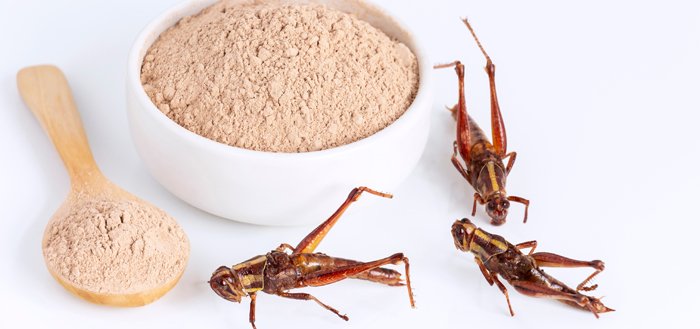Interview with Three Food Operators on Insect-based Protein overview
1039 Views |

Interviewed By: กันต์ธร หลีนวรัตน์
Kunthorn Leenavarat
Assistant Editor
Food Focus Thailand Magazine
editor@foodfocusthailand.com
ปัจจุบันนี้ ประชากรโลกมีมากกว่า 7,900 พันล้านคน และจากการคาดการณ์ จำนวนประชากรจะเพิ่มสูงขึ้นอย่างต่อเนื่องจนถึงปี 2643 จึงจะเริ่มคงที่ แน่นอนว่ากว่าจะถึงปีนั้น ประชากรโลกคงมีมากขึ้นกว่านี้อีกมากมาย และด้วยจำนวนประชากรที่เพิ่มมากขึ้นนี้เอง สิ่งที่น่ากังวลอันดับเเรกๆ คือปัญหาด้านสิ่งแวดล้อม รวมถึงข้อจำกัดด้านปริมาณอาหาร ว่าจะมีเพียงพอหรือไม่ จึงเป็นความท้าทายอย่างยิ่งในเตรียมรับมือและวางแนวทางการผลิตอาหารให้เพียงพอต่อความต้องการของประชากรโลกในอนาคต
โปรตีน คือหนึ่งในสารอาหารที่จำเป็นต่อการดำรงชีวิตของมนุษย์ แหล่งโปรตีนที่สำคัญส่วนใหญ่จะมาจากเนื้อสัตว์และพืชบางชนิด แต่เมื่อการศึกษาและวิจัยพบว่า การทำปศุสัตว์ คือสาเหตุอันดับต้นๆ ที่ก่อให้เกิดภาวะโลกร้อน ซึ่งส่งผลต่อความเป็นอยู่ของสิ่งมีชีวิตบนโลกใบนี้ จึงเกิดการค้นหาแหล่งโปรตีนใหม่ๆ ที่ปล่อยก๊าซเรือนกระจกน้อยที่สุด และพบว่า “แมลง” อาจจะเป็นทางเลือกที่เรากำลังตามหา เนื่องจากแมลงมีปริมาณโปรตีนสูง มีกรดอะมิโนที่ร่างกายต้องการครบถ้วน ผ่านการสังเคราะห์น้อย เลี้ยงง่าย ใช้พื้นที่และทรัพยากรในการเพาะเลี้ยงต่ำ แต่ประเด็นหนึ่งที่ยังเป็นที่กังขากับโปรตีนทางเลือกชนิดนี้ คือ รูปลักษณ์ภายนอก ที่ไม่ชวนให้น่ารับประทาน จึงเป็นเรื่องท้าทายของเหล่าผู้ประกอบการโปรตีนจากแมลงทั้งหลายที่จะต้องผ่านอุปสรรคข้อนี้ไปให้ได้
จากข้อมูลของ Global Market Insight พบว่า ตลาดแมลงและผลิตภัณฑ์เพื่อการบริโภคทั้งโลก มีมูลค่ารวม 112 ล้านเหรียญสหรัฐ ในปี 2562 โดยที่มูลค่าจะเพิ่มขึ้นเป็น 1.5 พันล้านเหรียญสหรัฐ ในปี 2569 นับว่ามีการเติบโตอย่างก้าวกระโดดเหมือนตั๊กแตนเลยทีเดียว ในครั้งนี้นิตยสาร Food Focus Thailand ขอเปิดบทสัมภาษณ์ผู้ประกอบการจากแมลง 3 ราย ได้แก่ The Bricket, Kokoonic และ Protanica ว่าตลาดโปรตีนจากเมลงนี้มีความน่าสนใจอย่างไร และแมลงชนิดใดที่ผู้ประกอบการให้ความสนใจ
The current 7.9 billion world population is expected to continuously rise until 2100 after which it is predicted to stabilize. Until that time comes, the global population growth will continue its steep path uphill and lead to some of the most disturbing issues: the environmental impacts and limited food supply. It is, therefore, a truly big challenge to prepare for the handling and planning of food production to ensure sufficient food supplies for the future generations.
Protein is a nutrient that is essential to human life. Most major sources of protein are animal meat and certain plants. According to research and studies, however, livestock farming ranks among first contributing factors of the global warming as it affects the very livelihood of all the living beings in the world. New sources of protein that emit the minimal amount of greenhouse gases are, hence, being developed, and insects may be a possible alternative that we are so relentlessly searching for because they are easy to raise and rich in protein and essential amino acids. They also require minimum synthesis, spaces, and farming resources. One aspect that remains doubtful is the insects’ physical appearance, which is far from being appetizingly inviting. Such is a challenge that all insect protein manufacturers need to overcome.
According to Global Market Insight, the global market of insects and insect-based consumable products reached the total value of USD 112 million in 2019. That figure is projected to spike by leaps and bounds like a grasshopper to USD 1.5 billion in 2026. Food Focus Thailand Magazine, therefore, takes this opportunity to share our interview with three insect protein operators—The Bricket, Kokoonic, and Protanica—on the interesting aspects of the insect protein market and the potential species of insect that food operators are keeping their eyes on.



